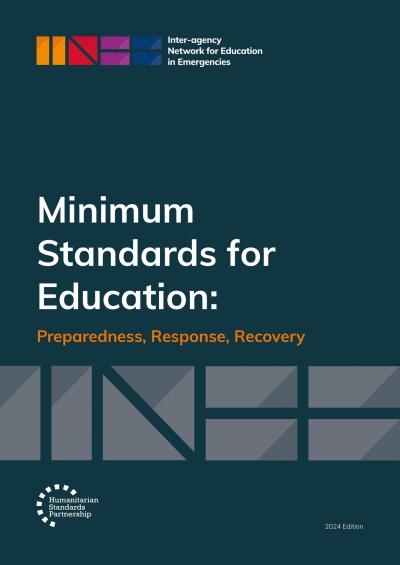INEE Minimum Standards, 2024 Edition
The INEE Minimum Standards for Education: Preparedness, Response, Recovery (INEE MS) contains 19 standards, each of which includes key actions and guidance notes. The purpose of the INEE MS is to improve the quality of educational preparedness, response, and recovery; to increase access to safe and relevant learning opportunities; and to ensure that the actors who provide these services are held accountable. The INEE MS are designed to be applicable to crisis response in many different situations, including emergencies caused by conflict, by natural hazards such as those induced by climate change, and slow- and rapid-onset crises in both rural and urban environments.
Click here to access the downloadable PDF. Click here for more information on the INEE MS, 2024 Edition, and related resources.

Domain 1: Foundational Standards for a Quality Response
Standard 1: Participation
Community members participate meaningfully, transparently, and without discrimination in the analysis, planning, design, implementation, monitoring, and evaluation of the education response.
Standard 2: Resources
Community resources are identified, mobilized, and used to implement age-appropriate learning opportunities.
Standard 3: Coordination
Education coordination mechanisms are in place to support the stakeholders who are working to ensure access to and continuity of quality education.
Standard 4: Assessment
Timely education assessments of the emergency situation are holistic, transparent, and participatory.
Standard 5: Response Strategies
Inclusive education response strategies include a clear description of the context and of the barriers to the right to education, and strategies to overcome those barriers.
Standard 6: Monitoring
There is regular monitoring of education response activities and of the evolving learning needs of the people affected.
Standard 7: Evaluation
Systematic and impartial evaluations improve education response activities and enhance accountability.
Domain 2: Access and Learning Environment
Standard 8: Equal and Equitable Access
All individuals have access to quality and relevant education opportunities.
Standard 9: Protection and Wellbeing
Learning environments are secure and safe, and they promote the protection and the psychosocial wellbeing of learners and teachers and other education personnel.
Standard 10: Facilities and Services
Education facilities promote the safety and wellbeing of learners and teachers and other education personnel, and are linked to health, nutrition, psychosocial, and protection services.
Domain 3: Teaching and Learning
Standard 11: Curricula
The curricula used to provide formal and non-formal education are culturally, socially, and linguistically relevant, and appropriate to the context and learner’s needs.
Standard 12: Teaching and Learning Processes
Teaching and learning processes are learner centered, participatory, and inclusive.
Standard 13: Assessment of Holistic Learning Outcomes
Appropriate methods are used to evaluate and validate holistic learning outcomes.
Standard 14: Training, Professional Development, and Support
Teachers and other education personnel receive regular, relevant, and structured training in line with their needs and circumstances.
Domain 4: Teachers and Other Education Personnel
Standard 15: Recruitment and Selection
A sufficient number of appropriately qualified teachers and other education personnel are recruited through a transparent and fair process, based on selection criteria reflecting diversity and equity.
Standard 16: Conditions of Work
Teachers and other education personnel have clearly defined conditions of work and receive appropriate compensation.
Standard 17: Support and Supervision
The support and supervision mechanisms in place for teachers and other education personnel function effectively.
Domain 5: Education Policy
Standard 18: Law and Policy Formulation
Education authorities prioritize the continuity and recovery of quality education, including free and inclusive access to learning.
Standard 19: Planning and Implementation
Education programs and activities reflect international and national educational policies, laws, standards, plans, and the learning needs of the people affected.




